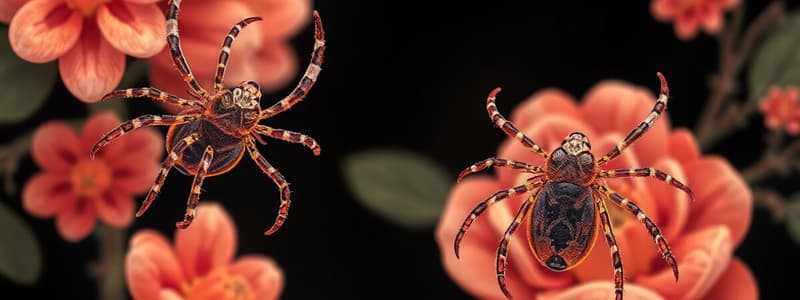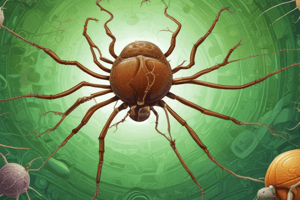Podcast
Questions and Answers
Which of the following statements accurately describes the role of erythrocytes in the Babesia microti life cycle within a mammalian host?
Which of the following statements accurately describes the role of erythrocytes in the Babesia microti life cycle within a mammalian host?
- Erythrocytes serve as the site where sporozoites undergo sexual reproduction, leading to the formation of gametes.
- Erythrocytes facilitate asexual reproduction of trophozoites, leading to the multiplication of blood-stage parasites and clinical manifestations. (correct)
- Erythrocytes are responsible for the differentiation of merozoites into sporozoites, initiating the next infectious stage.
- Erythrocytes act as a reservoir for dormant parasites, preventing the host's immune system from detecting the infection.
In the lifecycle of Babesia microti, what is the critical result of the sporogonic cycle that occurs within the tick vector?
In the lifecycle of Babesia microti, what is the critical result of the sporogonic cycle that occurs within the tick vector?
- Formation of male and female gametes, facilitating sexual reproduction within the tick's gut.
- Differentiation of merozoites into trophozoites, preparing for transmission to the mammalian host.
- Production of sporozoites within the salivary glands, enabling transmission to a new mammalian host during a blood meal. (correct)
- Development of trophozoites within the tick's salivary glands, ready to infect the next host.
Why is Babesiosis often misdiagnosed or overlooked in its early stages?
Why is Babesiosis often misdiagnosed or overlooked in its early stages?
- Infected individuals develop immunity quickly, suppressing symptoms below the threshold of clinical detection.
- Early symptoms mimic common viral infections, and specific diagnostic tests are not routinely performed. (correct)
- The parasite has a long incubation period, leading to delayed onset of noticeable symptoms.
- The disease primarily affects internal organs, making it difficult to detect through standard blood tests.
What is the fundamental mechanism by which Babesia microti causes anemia in infected individuals?
What is the fundamental mechanism by which Babesia microti causes anemia in infected individuals?
Given that humans are often a dead-end host for Babesia microti, what is the primary route of human-to-human transmission, and under what circumstances is it most likely to occur?
Given that humans are often a dead-end host for Babesia microti, what is the primary route of human-to-human transmission, and under what circumstances is it most likely to occur?
How would you best explain the significance of the 'Maltese cross' formation observed in red blood cells during microscopic diagnosis of Babesiosis?
How would you best explain the significance of the 'Maltese cross' formation observed in red blood cells during microscopic diagnosis of Babesiosis?
Considering the limitations and potential side effects of current treatments for Babesiosis (Atovaquone and Azithromycin), what novel therapeutic strategy might offer a more targeted and effective approach with fewer adverse effects?
Considering the limitations and potential side effects of current treatments for Babesiosis (Atovaquone and Azithromycin), what novel therapeutic strategy might offer a more targeted and effective approach with fewer adverse effects?
What specific feature of Babesia-infected ixodid ticks makes them effective vectors for transmitting the parasite to mammalian hosts?
What specific feature of Babesia-infected ixodid ticks makes them effective vectors for transmitting the parasite to mammalian hosts?
In regions where Babesiosis is endemic, what public health strategy would be most effective in reducing the incidence of new infections?
In regions where Babesiosis is endemic, what public health strategy would be most effective in reducing the incidence of new infections?
Why is it essential to consider Babesiosis in the differential diagnosis of patients presenting with malaria-like symptoms, especially in regions where both diseases are prevalent?
Why is it essential to consider Babesiosis in the differential diagnosis of patients presenting with malaria-like symptoms, especially in regions where both diseases are prevalent?
Flashcards
Babesiosis
Babesiosis
Acute illness resembling malaria, caused by the hemolysis of infected erythrocytes leading to severe anemia.
Sporozoite
Sporozoite
Infectious stage of Babesia; enters the bloodstream through a tick bite.
Trophozoite
Trophozoite
Matures inside red blood cells during Babesia infection.
Merozoite
Merozoite
Signup and view all the flashcards
Definitive host
Definitive host
Signup and view all the flashcards
Intermediate Host
Intermediate Host
Signup and view all the flashcards
Reservoir
Reservoir
Signup and view all the flashcards
Treatment
Treatment
Signup and view all the flashcards
Microscopy
Microscopy
Signup and view all the flashcards
Study Notes
- Babesia microti is a blood and tissue protozoan that causes Babesiosis disease.
- Babesiosis presents as an acute illness similar to malaria.
- Severe anemia results from the hemolysis of infected erythrocytes.
Babesia Life Cycle Stages
- Sporozoites are the infectious stage and enter the bloodstream through a tick bite.
- Trophozoites mature within red blood cells.
- Merozoites replicate and cause red blood cells to burst, spreading the infection.
Transmission and Hosts
- Babesiosis is transmitted through the bite of ixodid ticks.
- Ixodid ticks serve as the definitive host.
- Humans and other mammals are intermediate hosts.
- Small mammals and deer act as reservoirs.
- Ticks infected with Babesia introduce sporozoites into a host, such as a mouse or deer, during a blood meal.
- Sporozoites reproduce asexually inside erythrocytes in the mammalian host, with some differentiating into male and female gametes.
- When another tick bites the infected mammal, gametes unite and undergo a sporogonic cycle, producing sporozoites in the tick's salivary glands.
- Humans become infected when bitten by an infected tick, leading to asexual reproduction of sporozoites in erythrocytes, causing clinical manifestations.
- Humans are typically a dead-end host; however, human-to-human transmission is possible through blood transfusions.
Diagnosis and Treatment
- Diagnosis involves Microscopy, where a Maltese cross pattern in red blood cells is a characteristic sign.
- Trophozoites appear as thin-line structures within erythrocytes.
- Treatment includes Atovaquone (750mg twice daily) combined with azithromycin (500mg - 1 gram/day) for 7-10 days
Studying That Suits You
Use AI to generate personalized quizzes and flashcards to suit your learning preferences.




